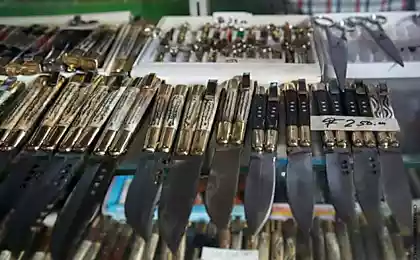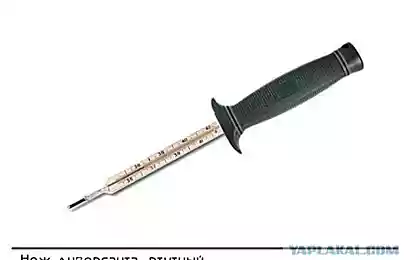1511
Balisong

Balisong - a folding knife and folding knives have a blade when not in any way hidden in the handle. In balisong handle longitudinally divided into two halves, each of which is pivotally connected to the blade shank. Along each groove is selected a handle halves, so that in cross-section is the similarity of the letter "P". In the folded position, the handle halves cover their grooves on both sides of the blade. When opening the halves rotate in opposite directions and converge from the back side to form a handle. The design is simple and concise, contains no springs, buttons and complicated locking devices. And, nevertheless, an experienced user can cause balisong in working position with one hand for a split second, not much slower than the automatic ("switchblade") knife, but with an external effect, than click "machine". And importantly, that the simplicity of the design points to its reliability: in balisong a "mechanism" virtually nothing to break, then he will always, and handle, covered by hand, never will emerge blade knife at the wrong time on the fingers of the owner.

Most fans appreciate his balisong knives for the opportunity to effectively their "twist". To refer to actions with a knife there is even a single word - fliping (Eng. Flipping on to flip - flip, flip, toss). Fans flipinga argue that balisong flailing hands calms the nerves and enters into a state similar to meditation.
How can balisong associated with the Philippines? Let's start with recent history, which can be verified by the facts. Considerable fame "Filipino butterfly knives" received only after the Second World War. Philippines then was the scene of clashes Japanese and American armies, before the war, the country was "autonomy within the United States", and later it was occupied by the Japanese, and then captured by the Americans. Here are US soldiers and brought home an unusual native knives with legends of their wonderful qualities. So balisong entered the world culture as a Filipino knife.

But where did the knife of similar design in the Philippines? Here it is not so simple. In some traditions of martial arts of the Philippines and, above all, Escrima system is believed that it was invented by balisong in the Philippines about 800 AD. Refute it is hardly possible, but what else documentary or physical evidence Filipino knife is not yet known. Meanwhile, its priority is not so long ago, said Europe: in one of the old French books described the design balisong that (design, not later books), treated, like, to the XVI century. Immediately proposed the theory that the balisong hit the Philippines through Spain, that is somewhere between the landing of the Philippines Ferdinand Magellan (1521) and the Philippine Revolution (1896-1898.). This theory sounds like, consistently, but also remains a theory.

Whatever it was, to balisong, apparently forever was attached the name of the Filipino knife. Especially because the word "balisong" is definitely Filipino roots. According to one of the two main versions of this reduction Tagalog «baling sungay» («broken horn"), that sounds reasonable, ie. A. A handle knives could well be made of animal horns. In another version of the name of a purely geographical: in the province of Batangas has a small settlement balisong at him and could be called knives. Currently balisong have in stock many of the world's leading manufacturers of knives, this is primarily American companies Benchmade, Microtech and Spyderco. However, the main producing region is South-East Asia.

Among the shortcomings can be noted balisong structural need for the length and width of the blade less than the corresponding dimensions of the handle (so the blade is usually narrow and relatively short, or the handle will have to make too long). There are significant limitations on the shape of the handle: halves must adhere to each other by both sides, it is difficult to make complete stops and podpaltsevye recess. On the mass of cheap balisong originating from Southeast Asia can be unreliable and short-lived joints. Well, perhaps the last, but rather a major drawback - the ratio of the knife as a weapon, causing societal prejudice and legal restrictions. In the homeland of the knife, the Philippines, it is forbidden to sell balisong 29-cm length. In the US, federal law prohibited certain "gravity" and "inertia" knives, but that they are understood in fact determined by the lawyers, so the state of the balisong banned, in part - no. Russian Weapons Act is largely copied from the US, along with phrases about "inertial knives", but the opinion of Russian experts less vague: balisong priori crime at the length of the blade more than 90 mm. It's not much, but still leaves the right lovers of exotic Philippine acquire a number of short and specially designed legal models that are not machetes.
























